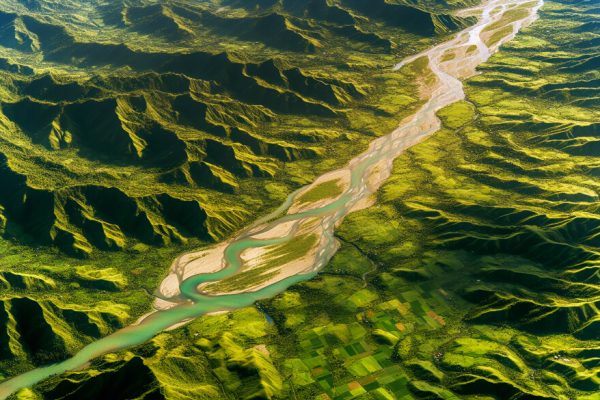As drones have advanced over the past few years, they have become a critical aspect in the response efforts of many public agencies in the USA during natural disasters. Many public safety personnel are able to leverage drones for more insight throughout hazard mitigation, response efforts, and post-event recovery. In this article – we take a look at how drones can be leveraged during emergency and natural disaster situations and some of the benefits in doing so.
Quick Summary on How Drones Aid in Emergency & Natural Disaster Response
- Drones are becoming more and more popular in the emergency response efforts and are used across many public safety agencies and first responders in the U.S.
- Drones offers remote monitoring capabilities in areas that are typically inaccessible by human personnel and manned vehicles.
- Drones with added features like thermal imaging have the ability to monitor and prevent natural disasters like wildfires by detecting hotspots and high-risk areas.
Drones for Emergency Management & Disaster Response
Agencies across the US have either in-house trained and FAA certified drone pilots to leverage during emergency response or drone services companies are utilized.
Drones have the capability to survey hard-to-reach areas which can aid emergency personnel assess the situation to create a course of action. Drones and data captured by drones have become pivotal in creating plans or COAs for search and rescue missions, disaster management, or disaster relief efforts. The data and insight provided by drones creates a more complete picture for the experts on the ground.
The imagery and data captured by drones can be used for pre-incident and post-disaster planning, helping recovery teams prevent tragedies. Oftentimes drones are used in the operational element of a response. Drones are a cost-effective way to rapidly capture data-driven insights that offer a safer means of data acquisition, regardless of environmental elements.
Real Life Applications for Search and Rescue Drones
Drones can be leveraged in a number of ways – below we work through real life use-cases.
Drones for Disaster Response
Drones have proven to be mission critical in disaster response –
- Provide data in near-real time to inform decisions on the ground and increase situational awareness
- Operate in dangerous areas so that first responders don’t need to be put in harm’s way
- Cover large swathes of area, including remote and hard to access areas, allowing for more efficient use of public safety personnel and resources
- Provide technical capabilities that humans cannot, such as thermal or infrared scanning
Drones for Fire Prediction, Prevention, and Fighting
Researchers at the University of Montana have started using drones for forest fire prediction, more on this here. Drones can be equipped with sensors to measure temperature, humidity, location, wind speed and direction. Scientists in Montana used drones to help predict fires. The drones are used to measure variables like temperature, humidity, position, wind velocity and direction. In California – emergency teams have leveraged drones for detection as well (source).
Thermal sensors deployed on a drone can use infrared radiation to help detect heat signatures allowing emergency personnel to identify fire hotspots. These innovations can show where fires are most likely to spread.
Additionally – utility companies have begun to examine whether drone technology could reduce conflagration and improve infrastructure inspections to prevent fires resulting from a recurrence. California has implemented drones to detect forest fires, providing a glimpse of the kind and quantity of materials required at the scene (source).
The Department of Interior have also leveraged drones in firefighting, particularly through controlled burning. In 2020 during a wildfire in CO, a drone dropped small incendiary balls to create a more effective containment line and deny fuel for the wildfire (source).
Drones for Search and Rescue Missions
The Department of Homeland Security has led research into the use of emergency drones in search and rescue operations. Thermals can help detect people where they may not be easily seen which could mean trapped under debris, wreckage, rubble, and/or taking cover for safety until help arrives. Drones can also fly into areas where typical manned search and rescue aircraft cannot, such as tunnels thus improving the search and rescue operation.
During a flash flood, drones can be deployed to offer a bird’s-eye view of where water is flowing and can help personnel predict where water levels could rise. Public safety personnel can also leverage drones for disaster response in similar situations, such as earthquakes, hurricanes or landslides. The drone team at FSU was able to employ these tactics to help the rescue and recovery effort from Hurricane Ida (source).
Drones for Post-Disaster
Drones can also be utilized to survey the damage in the aftermath of a natural disaster or catastrophic event. Drones can capture video and high quality aerial imagery to help assess damage. This data can then be used for prevention efforts by highlighting vulnerable areas susceptible to flash flooding and/or landslides.
Drones can be equipped with communication antennas can help restore comm lines for emergency personnel after the loss of traditional telco lines. When comms are down, it’s harder to connect people in need with water, food, and medical supplies.
In future applications – drones may be able to deliver life-saving equipment such as automated external defibrillators (AED) and emergency medication since these units may be capable of arriving the scene of the emergency quicker than traditional means.
Necessary Drone Features for Emergency & Disaster Response
It’s clear why drone systems have become so popular in many sectors compared to the drone industry. Drones are used to help disasters. You have the opportunity to indulge and enjoy the latest features. Rescue personnel can plan better through a real-time image that accurately records conditions at the scene. When disaster personnel gather pertinent data before the event, they can prepare more quickly for an incident. Drone systems can offer accurate data in real time using AI technology.
- Durable and Deployable Hardware – a drone that can withstand the weather and conditions of the emergency or disaster.
- Real-Time Imagery – accurate reports of the condition
- Long-Lasting Battery – it goes without saying in disaster management, a good battery is a must.
- Thermal Imaging – thermal provides more insight, ability to location people or animals faster.
- Wide Surveillance Scope – a larger FOV (field of view) can ensure proper data captures and more insight during and after the mission set
- Weather Forecasting – a “nice to have” feature – if drones have Wx sensing sensors it will aid in operations
Benefits of Using Drones in Disaster Relief
Below are the succinct examples of how drones benefit the emergency and disaster management community.
Drones for Hazard Mitigation Drones
Drones help prevent destruction or damage from future natural disaster events through aerial imagery data and insight. Aerial images captured by a drone before a disaster takes place may be helpful in helping experts assess pre-event hazards that could be mitigated before a disaster.
For example, building and infrastructure fortification and implementing changes to make the structures more storm or disaster-resistant. Possible enhancements could include wind-retrofitting buildings, roof enhancements or reporting existing damage whose condition would decline during a disaster.
Drones for Rebuilding and Recovery
Drones offer an ability to quickly and safely gather imagery of disaster areas in a safe fashion. The data captured by drones can assist the response teams on determining what areas are safe, which areas need repair, and which areas are completely lost. The video and imagery can help organizations place priority on certain areas and asses where additional equipment or resources are needed.
Drones for Disaster Mitigation
Drones can be leveraged to assess vulnerable landscapes and challenging terrains prior to a emergency or natural disaster. In some cases, drone technology and data coupled with artificial intelligence software can be used to determine pre-incident plans and rescue operations.
Drones can conduct assessments of energy infrastructure, transportation systems, communication towers, and any other critical systems before a disaster. High-resolution videos and photos can aid in identifying and prioritizing efforts to fortify vulnerable areas.
Safe Monitoring of Disaster Sites
Drones can be used as a way to continuously monitor disaster sites with much less overhead than traditional manned aircraft patrol. After a disaster the safety risks increase in damaged areas. Drones can monitor these hazardous areas and report on the recovery and rebuilding efforts.





